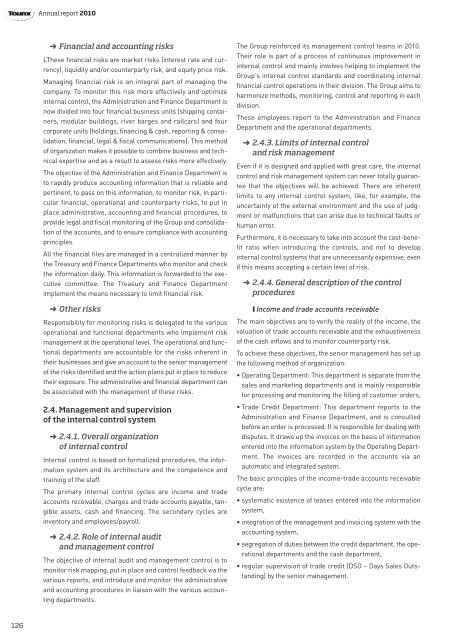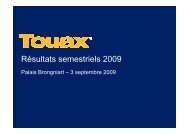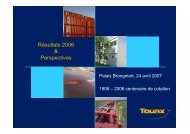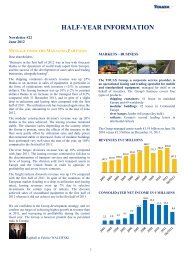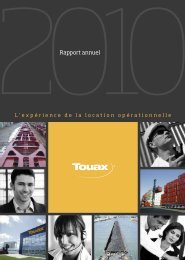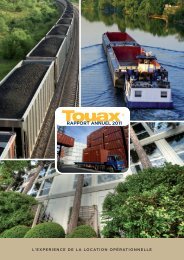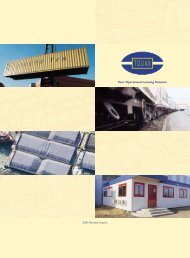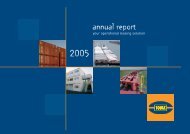2010 annual report - touax group
2010 annual report - touax group
2010 annual report - touax group
Create successful ePaper yourself
Turn your PDF publications into a flip-book with our unique Google optimized e-Paper software.
Annual <strong>report</strong> <strong>2010</strong><br />
➜ Financial and accounting risks<br />
LThese financial risks are market risks (interest rate and currency),<br />
liquidity and/or counterparty risk, and equity price risk.<br />
Managing financial risk is an integral part of managing the<br />
company. To monitor this risk more effectively and optimize<br />
internal control, the Administration and Finance Department is<br />
now divided into four financial business units (shipping containers,<br />
modular buildings, river barges and railcars) and four<br />
corporate units (holdings, financing & cash, <strong>report</strong>ing & consolidation,<br />
financial, legal & fiscal communications). This method<br />
of organization makes it possible to combine business and technical<br />
expertise and as a result to assess risks more effectively.<br />
The objective of the Administration and Finance Department is<br />
to rapidly produce accounting information that is reliable and<br />
pertinent, to pass on this information, to monitor risk, in particular<br />
financial, operational and counterparty risks, to put in<br />
place administrative, accounting and financial procedures, to<br />
provide legal and fiscal monitoring of the Group and consolidation<br />
of the accounts, and to ensure compliance with accounting<br />
principles.<br />
All the financial files are managed in a centralized manner by<br />
the Treasury and Finance Departments who monitor and check<br />
the information daily. This information is forwarded to the executive<br />
committee. The Treasury and Finance Department<br />
implement the means necessary to limit financial risk.<br />
➜ Other risks<br />
Responsibility for monitoring risks is delegated to the various<br />
operational and functional departments who implement risk<br />
management at the operational level. The operational and functional<br />
departments are accountable for the risks inherent in<br />
their businesses and give an account to the senior management<br />
of the risks identified and the action plans put in place to reduce<br />
their exposure. The administrative and financial department can<br />
be associated with the management of these risks.<br />
2.4. Management and supervision<br />
of the internal control system<br />
➜ 2.4.1. Overall organization<br />
of internal control<br />
Internal control is based on formalized procedures, the information<br />
system and its architecture and the competence and<br />
training of the staff.<br />
The primary internal control cycles are income and trade<br />
accounts receivable, charges and trade accounts payable, tangible<br />
assets, cash and financing. The secondary cycles are<br />
inventory and employees/payroll.<br />
➜ 2.4.2. Role of internal audit<br />
and management control<br />
The objective of internal audit and management control is to<br />
monitor risk mapping, put in place and control feedback via the<br />
various <strong>report</strong>s, and introduce and monitor the administrative<br />
and accounting procedures in liaison with the various accounting<br />
departments.<br />
The Group reinforced its management control teams in <strong>2010</strong>.<br />
Their role is part of a process of continuous improvement in<br />
internal control and mainly involves helping to implement the<br />
Group's internal control standards and coordinating internal<br />
financial control operations in their division. The Group aims to<br />
harmonize methods, monitoring, control and <strong>report</strong>ing in each<br />
division.<br />
These employees <strong>report</strong> to the Administration and Finance<br />
Department and the operational departments.<br />
➜ 2.4.3. Limits of internal control<br />
and risk management<br />
Even if it is designed and applied with great care, the internal<br />
control and risk management system can never totally guarantee<br />
that the objectives will be achieved. There are inherent<br />
limits to any internal control system, like, for example, the<br />
uncertainty of the external environment and the use of judgment<br />
or malfunctions that can arise due to technical faults or<br />
human error.<br />
Furthermore, it is necessary to take into account the cost-benefit<br />
ratio when introducing the controls, and not to develop<br />
internal control systems that are unnecessarily expensive, even<br />
if this means accepting a certain level of risk.<br />
➜ 2.4.4. General description of the control<br />
procedures<br />
❙ Income and trade accounts receivable<br />
The main objectives are to verify the reality of the income, the<br />
valuation of trade accounts receivable and the exhaustiveness<br />
of the cash inflows and to monitor counterparty risk.<br />
To achieve these objectives, the senior management has set up<br />
the following method of organization:<br />
• Operating Department: This department is separate from the<br />
sales and marketing departments and is mainly responsible<br />
for processing and monitoring the filling of customer orders,<br />
• Trade Credit Department: This department <strong>report</strong>s to the<br />
Administration and Finance Department, and is consulted<br />
before an order is processed. It is responsible for dealing with<br />
disputes. It draws up the invoices on the basis of information<br />
entered into the information system by the Operating Department.<br />
The invoices are recorded in the accounts via an<br />
automatic and integrated system.<br />
The basic principles of the income-trade accounts receivable<br />
cycle are:<br />
• systematic existence of leases entered into the information<br />
system,<br />
• integration of the management and invoicing system with the<br />
accounting system,<br />
• segregation of duties between the credit department, the operational<br />
departments and the cash department,<br />
• regular supervision of trade credit (DSO – Days Sales Outstanding)<br />
by the senior management.<br />
126


